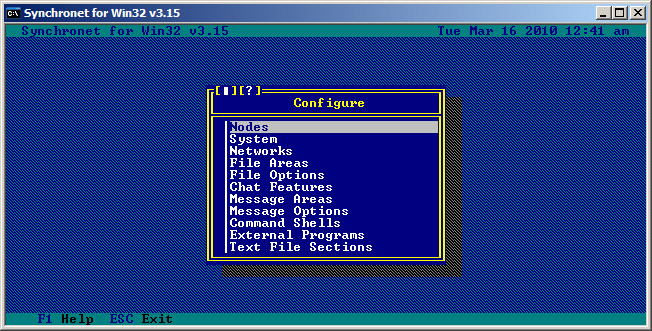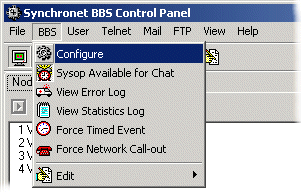This is an old revision of the document!
Table of Contents
SCFG
The Synchronet Configuration Utility (SCFG) is used for viewing and modifying the various CNF files in the Synchronet ctrl directory.
Invoking
SCFG may be invoked from the Synchronet Control Panel with the BBS->Configure menu option:
Or by running scfg from a command prompt.

exec directory is not in your search path, you may need to change the current working directory (e.g. using cd) or specify the full path to scfg.
Executable
SCFG is a native executable program.
On Windows, the executable file is: exec/scfg.exe
On Unix, the executable file is: exec/scfg
Command-line Usage
Help on the command-line usage can be displayed by executing the command: scfg -? or scfg –help:
usage: scfg [ctrl_dir] [options]
options:
-s = don't check directories
-f = force save of config files
-a = update all message base status headers
-h = don't update message base status headers
-u# = set file creation permissions mask (in octal)
-c = force color mode
-m = force monochrome mode
-e# = set escape delay to #msec
-iX = set interface mode to X (default=auto) where X is one of:
X = X11 mode
C = Curses mode
F = Curses mode with forced IBM charset
W = Win32 native mode
A = ANSI mode
D = standard input/output/door mode
-v# = set video mode to # (default=auto)
-l# = set screen lines to # (default=auto-detect)
-b# = set automatic back-up level (default=5)
-y = automatically save changes (don't ask)

CTRL Directory
If the SBBSCTRL environment variable is set, then SCFG will find the CNF files without needing you to specify the path to the ctrl directory ([ctrl_dir]) on the command-line.
If the SBBSCTRL environment variable is not set and the [ctrl_dir] is not specified on the command-line, SCFG will look for the CNF files in the current working directory.
Help Files

Using SCFG
Standard I/O Mode

Full-screen Mode


